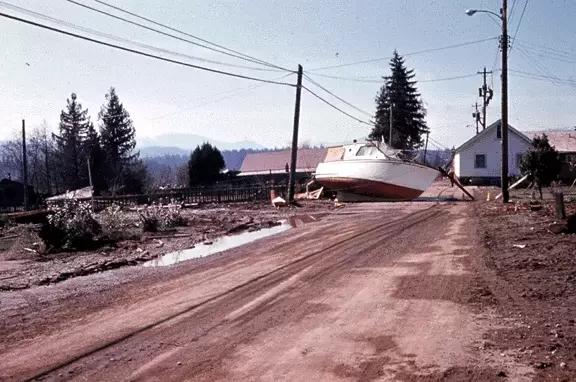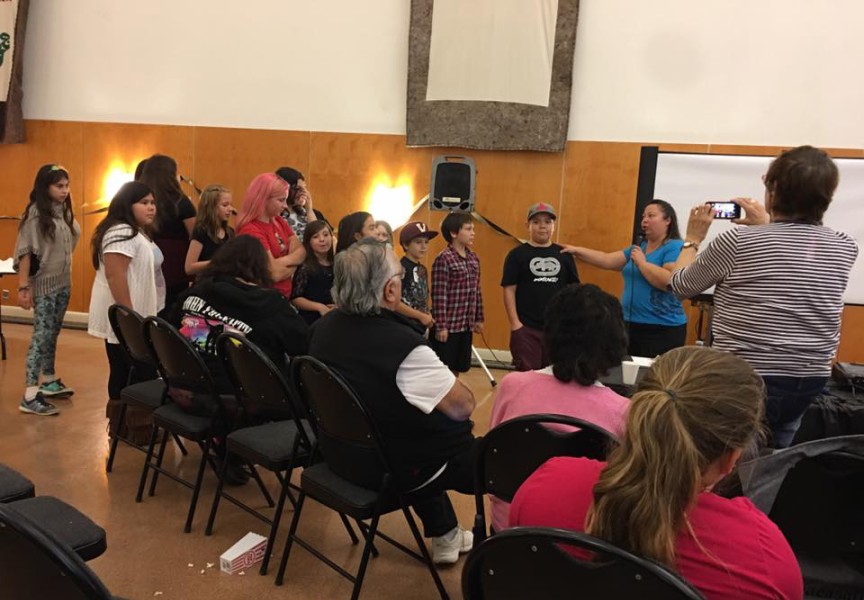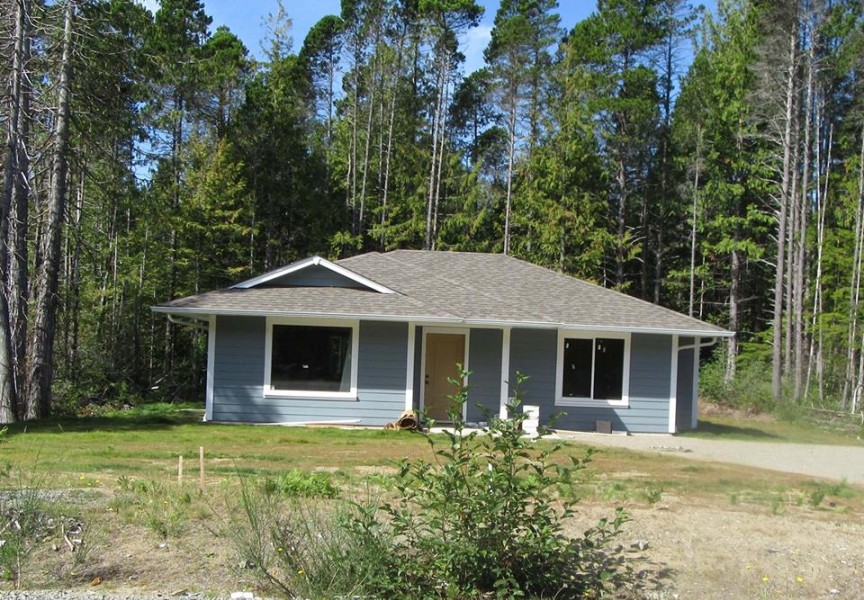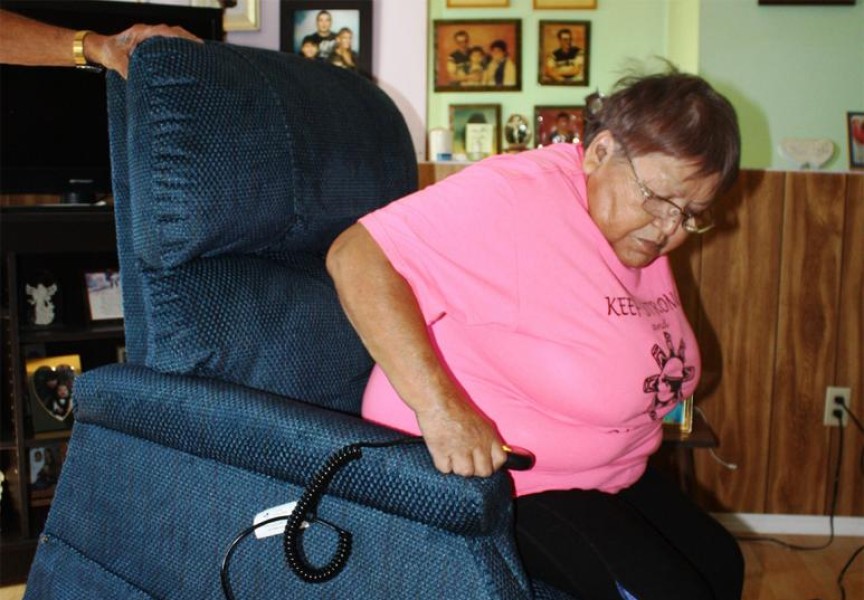On March 27, 1964, the largest ever recorded earthquake in North America struck near Alaska’s Prince William Sound. The 9.2 quake violently shook the earth for nearly three minutes and generated a series of tsunamis that would fan out across the Pacific Ocean to places as far away as California.
The quake and subsequent tsunamis resulted in the deaths of 133 people and cost millions of dollars in damage in both the U.S .and Canada.
The quake struck at 5:27 p.m. and sent towering waves down the Pacific Coast. Exposed coastal communities and those at the end of inlets suffered the worst damage.
The tsunami struck the unsuspecting village at Hot Springs Cove about 11 p.m. as people were settling down for the night. The old village site was built at the head of the cove and almost all the homes were destroyed.
An hour later the tsunami funnelled its way up the Alberni Inlet, picking up momentum as it pushed its way through the narrow channel.
Back then Alberni and Port Alberni were two separate cities. Port Alberni was to the south and centered around the present day Harbour Quay. Alberni was located on the north end of the pulp mill. Each city had its own fire hall and police department.
People who experienced the tsunami as it happened will talk about the noises they heard and how frightening that was. Many say they didn’t know what was happening and most didn’t know the word tsunami. Back then they called them tidal waves, conjuring up images of towering waves swallowing up everything along the shoreline.
Harry Lucas was a 22-year-old young man who happened to be visiting with his parents and brother at the time. The home his parents lived in was on the Third Avenue hill near the present day Port Alberni Thrift Store. Back then there were houses in the area behind the thrift store that faced Kingsway Ave. The houses overlooked the inlet, the mills along the shoreline and lower Third Ave.
It was dark but the streets and parking lots were lit up with street lights that never went out during the catastrophe.
“The first thing I heard was honking on the street down the hill,” Lucas remembered. When he and his brother Moses looked out into the darkness they could see people walking in ankle-deep water down the hill and they wondered what was going on.
“Me and my brother Mo heard the surge of water rumbling in. Then we saw a two-foot surge coming in that washed down across (lower) Third Avenue,” he said. Lucas said that within about 45 minutes lower Third Avenue was under about five-and-a-half feet of water.
“We could see logs and cars drifting away from the mill,” Lucas recalled. In 1964 the logging industry in Port Alberni was booming. Logs were transported up the inlet to freighters in floating log booms. The force of the tsunami broke up the log booms sending a tangle of logs upstream, depositing them all over lower Alberni and Port Alberni.
On Third Avenue at the bottom of Redford Street near the present day Marlowe Marine stood the original Barclay Hotel.
The Lucas brothers could hear people screaming as they ran from the hotel and from the mills in an attempt to rescue their cars. They could hear the squeal of floats at the nearby fishermen’s wharf straining against the pilings and roar of the steam escaping both Somass Mill and the pulp mill.
“It was so loud. We thought they would explode,” Lucas added.
There had been a freighter anchored in the inlet that night and they saw the surge dragging it up the inlet as far as the pulp mill. “I guess its anchor was strong enough that it stopped right there,” said Lucas.
Throughout the night the brothers heard people yelling and screaming. They say it took about two hours before the water receded for good.
At daylight Lucas said the damage was awesome to see; awesome in terms of the magnitude of the destruction. They couldn’t walk on lower Third Avenue and all of River Road and the Alberni business district was shut down.
Motioning with his fingers tangled together, Lucas said, “it was full of cars and logs all twisted together and we thought for sure some people must have drowned, but nobody did.”
Beyond his view from his parents’ house was a rooming house that sat where Clutesi Haven Marina is at the corner of River and Beaver Creek roads. “That was all gone,” said Lucas, adding that lower Alberni seemed to get hit worse than Port Alberni.
He estimates the damage from the tsunami went as high as the present day 7-11 store at the corner of Johnston Road and Gertrude Street.
“Me and Ray Martin saw a car up on a roof,” Lucas said.
The Somass Mill parking lot had been filled with the cars of night shift workers when the tsunami struck. Some were saved but many floated away.
“All of the flats were covered with logs tangled like toothpicks,” Lucas recalled. There was a freighter that was stuck but was floated out on a high tide.
Looking back on it Lucas admitted they were scared. “We were afraid a really big wave would come in,” he said.
And when he hears a tsunami warning he takes it very seriously.
John Watts, 65, of Tseshaht, was a 15-year-old boy living alongside the Somass River on Hector Road with his parents and siblings.
He remembers being woken in the middle of the night by his father who was telling the kids to get up and get dressed because something was going on.
“I was sleeping with my two brothers and we didn’t listen to dad,” he remembered, adding they just wanted to get back to sleep.
The next time John’s father came in the room he was yelling loud, “Get the hell up and get dressed, there’s a tidal wave coming!”
The brothers got dressed and set out in the late night darkness on a five-minute walk up a little hill toward Paper Mill Dam. “It happened fast. Water was already coming up the road and we had to walk through the water up to our knees…it was like a real fast high tide,” he recalled.
John remembers he and his brothers were not so much scared as excited. “That was probably because of our age that we didn’t panic. We just laughed,” he said.
Eager to see what was going on, they made their way down an old logging road that used to be up on Watty’s Hill. The road took them to the Orange Bridge.
“We stood on the bridge and watched all the action,” said John.
The boys saw logs from the broken up log booms down the inlet float backwards up the river under the bridge and then saw them pass back under the bridge on their way back out with the receding water.
“We stayed there all night and watched,” said John.
He said lots of people down the inlet lost boats but, he figures, from their position at the river bend, they were just high enough to avoid damage and losses.
NTC receptionist Cathy Watts was six years old the night the tsunami struck. She recalls the loud sounds…the roar of rushing water and people screaming as she hid under her bed.
In the end about 350 homes were damaged and 58 totally destroyed. The neighbor cities amalgamated in 1967, becoming Port Alberni, largely because of the devastation caused by the tsunami.
There is now an early warning system installed around lower Port Alberni.
Fifty years after the tsunami the Government of British Columbia announced it is launching a formal consultation process on earthquake preparedness.
They say they will be reaching out to the people to raise the level of public education on the issue.
“This is part of how we must continually strive to improve our level of preparedness,” said BC Ministry of Justice on March 26.







